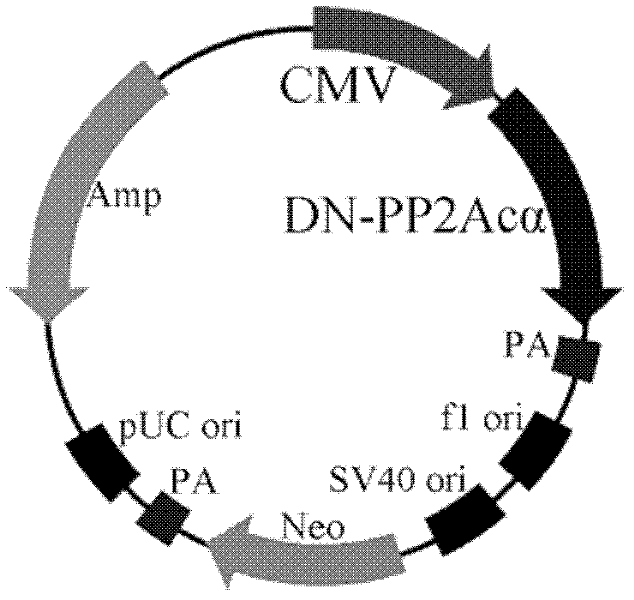Recombinant plasmid and virus of tissue specificity and application thereof.
A technology of recombining plasmids and viruses, applied in the fields of application, virus/bacteriophage, recombinant DNA technology, etc., can solve the problems of toxicity, inability to distinguish tumor cells and normal cells, etc., to avoid influence, good clinical application prospects, and avoid normal cells. The effect of cellular influence
- Summary
- Abstract
- Description
- Claims
- Application Information
AI Technical Summary
Problems solved by technology
Method used
Image
Examples
Embodiment 1
[0045] Example 1: Cloning PP2Ac and mutating it into DN-PP2Ac by site-directed mutagenesis
[0046] The inventor has constructed the PP2Ac expression plasmid pcDNA3.1-PP2Acα in previous studies (see Li W, et al.. Cancer Lett 2011; 304: 117-27), and the plasmid map is as follows figure 1 shown. The PP2Ac gene sequence is shown in SEQ ID No.4 or SEQ ID No.5.
[0047] The DN-PP2Ac expression plasmid was obtained from pcDNA3.1-PP2Acα by site-directed mutagenesis. The mutated plasmid was named pcDNA3.1-DN-PP2Acα. It was confirmed by sequencing that the 199th leucine (CTG) of PP2Acα had been mutated to proline (CCG). The amino acid sequence of PP2Acα is shown in SEQ ID No.6, and the amino acid sequence of the negative dominant mutant DN-PP2Acα expressed after mutation is shown in SEQ ID No.1.
Embodiment 2
[0048] Example 2: Functional identification of DN-PP2Ac
[0049] A protein phosphatase activity detection kit (Nonradioactive serine / threonine-phosphatase assay kit, purchased from Promega) was used to detect the inhibitory effect of DN-PP2Ac expression on PP2A activity. The normal human liver cell line L-02, and the liver cancer cell lines SK-Hep-1 and HepG2 were transfected with pcDNA3.1-DN-PP2Acα, and the results were as follows: figure 2 As shown, after transfection of pcDNA3.1-DN-PP2Acα into human liver cell line L-02, and liver cancer cell lines SK-Hep-1 and HepG2, its PP2A activity was significantly inhibited, and the difference was statistically significant compared with the control group .
[0050] The relative PP2A activity (relative PP2A activity) was calculated according to the following formula. Relative activity of PP2A=(PP2A activity of treatment group / PP2A activity of control group)×100%.
[0051] MTT assay was used to detect the inhibitory effect of DN-PP2...
Embodiment 3
[0054] Embodiment 3: Construction of AFpg promoter
[0055] AFP enhancer has tissue specificity but not strong transcriptional activity; pgk promoter has strong transcriptional activity but not tissue specificity. The combination of the two can have tissue specificity and strong transcriptional activity at the same time. The nucleotide sequence of the AFP enhancer is shown in SEQ ID No.2, and the nucleotide sequence of the pgk promoter is shown in SEQ ID No.3.
[0056] Using genomic DNA of liver cancer cell HepG2 as a template, the AFP enhancer and pgk promoter were cloned by PCR, and the two were constructed into the luciferase reporter gene vector pGL3-Basic (purchased from Promega Company), and the resulting plasmid was named pGL3-Basic- AFpg. Plasmid map such as Figure 4 shown.
PUM
 Login to View More
Login to View More Abstract
Description
Claims
Application Information
 Login to View More
Login to View More - R&D
- Intellectual Property
- Life Sciences
- Materials
- Tech Scout
- Unparalleled Data Quality
- Higher Quality Content
- 60% Fewer Hallucinations
Browse by: Latest US Patents, China's latest patents, Technical Efficacy Thesaurus, Application Domain, Technology Topic, Popular Technical Reports.
© 2025 PatSnap. All rights reserved.Legal|Privacy policy|Modern Slavery Act Transparency Statement|Sitemap|About US| Contact US: help@patsnap.com



